- Searching for milfoil in Pawtuckaway poses our biggest challenge and consumes most of our Milfoil Team’s time and energy. Surveying the whole lake by diving is not feasible so we keep looking for ways to make searching more efficient. Side scan sonar may provide us with such a capability. In 2020, at the recommendation of Lamprey River Advisory Committee (LRAC)
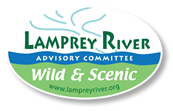 member Therese Thompson, the PLIA applied for a grant to obtain a high tech structure scan sonar unit. We hope this equipment will enable us to efficiently and repeatedly scan large areas of the lake to locate new and existing areas of milfoil. On April 21, 2020, LRAC unanimously approved our grant proposal. We thank the Lamprey River Advisory Committee for their generous support and for giving us this opportunity to explore new avenues to respond to the threat of invasive aquatic species in NH lakes. Pawtuckaway Lake is part of the Lamprey River Watershed and keeping it clean benefits the entire system. You can read Milfoil Team leader Neil Santos’s report here.
member Therese Thompson, the PLIA applied for a grant to obtain a high tech structure scan sonar unit. We hope this equipment will enable us to efficiently and repeatedly scan large areas of the lake to locate new and existing areas of milfoil. On April 21, 2020, LRAC unanimously approved our grant proposal. We thank the Lamprey River Advisory Committee for their generous support and for giving us this opportunity to explore new avenues to respond to the threat of invasive aquatic species in NH lakes. Pawtuckaway Lake is part of the Lamprey River Watershed and keeping it clean benefits the entire system. You can read Milfoil Team leader Neil Santos’s report here. - In 2017 the Pawtuckaway Lake Improvement Association received a $5,000 prize in connection with Neil Santos’s work with his Milfoil Snorkel Team. Neil was selected as a Cox Conserves Heroes finalist for the Boston area for his volunteerism and for developing a program to identify, mark, and schedule for removal the Variable Milfoil that had been discovered growing in Pawtuckaway Lake in late summer of 2015.
 Cox Conserves Heroes is a national awards program that honors and celebrates environmental volunteers across the country. Please read the story on their website. On August 24, a team from WFXT Boston 25 came to the lake to profile Neil as one of three finalists for the Boston area Cox Conserves Heroes award.Pawtuckaway Lake is the location of a State Park offering camping, hiking, swimming, and fishing for visitors and residents alike. Keeping it clean and free of invasive weeds benefits all who enjoy its natural beauty, and that is one of the primary goals of the PLIA. It’s what Neil and his snorkel team devote hundreds of hours to doing.Neil originally joined the PLIA’s Weed Watcher Program searching in and around the lake for invasive species. After the discovery of milfoil growing in the channel not far from his home, Neil decided to assemble a team of volunteers who would snorkel the infested area to search and mark new milfoil growths. Later specially trained divers from NH DES would come to remove the plants identified by Neil and his team. Because the work of this group has developed a very specific purpose and its focus remains on milfoil, its mission has expanded beyond weed watching. For that reason, the PLIA created a separate program, emerging from its Weed Watcher Program, called the Milfoil Management Program.
Cox Conserves Heroes is a national awards program that honors and celebrates environmental volunteers across the country. Please read the story on their website. On August 24, a team from WFXT Boston 25 came to the lake to profile Neil as one of three finalists for the Boston area Cox Conserves Heroes award.Pawtuckaway Lake is the location of a State Park offering camping, hiking, swimming, and fishing for visitors and residents alike. Keeping it clean and free of invasive weeds benefits all who enjoy its natural beauty, and that is one of the primary goals of the PLIA. It’s what Neil and his snorkel team devote hundreds of hours to doing.Neil originally joined the PLIA’s Weed Watcher Program searching in and around the lake for invasive species. After the discovery of milfoil growing in the channel not far from his home, Neil decided to assemble a team of volunteers who would snorkel the infested area to search and mark new milfoil growths. Later specially trained divers from NH DES would come to remove the plants identified by Neil and his team. Because the work of this group has developed a very specific purpose and its focus remains on milfoil, its mission has expanded beyond weed watching. For that reason, the PLIA created a separate program, emerging from its Weed Watcher Program, called the Milfoil Management Program. - In 2011 the PLIA learned that NH DES was developing a plan to use Pawtuckaway Lake for storage of water to relieve drought conditions in the Lamprey River Watershed of which it is a part. As PLIA members were alerted to this project, they expressed concerns about its impact on the lake and a desire to be heard on the issue. The PLIA was able to focus this response and develop a meaningful dialogue with DES that included several public hearings with specific attention paid to Pawtuckaway Lake and its needs. As a result of this initiative by PLIA leadership, dedicated members, and Nottingham Town officials, DES included a highly significant and perhaps historic provision in its 8/29/13 Decision affecting winter drawdown of Pawtuckaway Lake. It promised a collaboration between stakeholders like PLIA and the DES in monitoring and managing future lake water use and health, in implementation of both the new drawdown and the overall Lamprey River Management Plan.
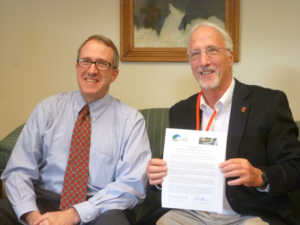 A written agreement of cooperation was drafted and signed by our President and NH DES Commissioner Tom Burack in October of 2013, making us the first lake association in NH to have this kind of working relationship. The objectives that all were able to agree on are Pawtuckaway Lake as a healthy and viable recreational resource as well as water for the health of the Lamprey River Watershed and its aquatic species. Although the Agreement reached its term and has now expired, thanks to this history, the PLIA continues to enjoy a close working relationship with NH DES.
A written agreement of cooperation was drafted and signed by our President and NH DES Commissioner Tom Burack in October of 2013, making us the first lake association in NH to have this kind of working relationship. The objectives that all were able to agree on are Pawtuckaway Lake as a healthy and viable recreational resource as well as water for the health of the Lamprey River Watershed and its aquatic species. Although the Agreement reached its term and has now expired, thanks to this history, the PLIA continues to enjoy a close working relationship with NH DES.
As a benefit of the Partnership Agreement, NH DES has conducted aquatic plant surveys at Pawtuckaway Lake over several years using sonar and collections by hand sampling. The initial results form a baseline that allows DES to compare surveys conducted over a period of years. When Variable Milfoil was detected in late summer of 2015 near a State Park boat ramp, DES was able to inspect the sonar survey from the previous year to determine whether it was new or established growth. 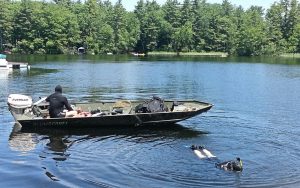 The response of DES to this emergency was a swift and thorough removal of the weed by specially certified divers, and a promise of future monitoring of this area.
The response of DES to this emergency was a swift and thorough removal of the weed by specially certified divers, and a promise of future monitoring of this area.
In addition, our Partnership with NH DES has provided increased water testing and management. In 2014, DES measured stream height and phosphorus concentrations at the outlet dams during the fall drawdown. 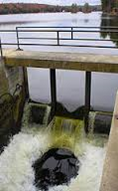 From these measurements, DES calculated the amount of phosphorus exported from each dam. As a comparison with past operations, DES also estimated the phosphorus export if the 2015 release followed historic operations. At the request of PLIA President Tom Duffy, fall drawdown practices were changed to direct most of the flow out of the lake via Drowns Dam instead of Dolloff Dam. This produced a much greater export of phosphorus as a result of discharging water with a higher concentration of phosphorous. DES estimates that the historical drawdown practices would have released 350 pounds of phosphorus. The new drawdown operations released 1066 pounds of phosphorus (716 pounds more than would have been historically released). This exciting and encouraging development holds significant promise for the improved health of Pawtuckaway’s waters.
From these measurements, DES calculated the amount of phosphorus exported from each dam. As a comparison with past operations, DES also estimated the phosphorus export if the 2015 release followed historic operations. At the request of PLIA President Tom Duffy, fall drawdown practices were changed to direct most of the flow out of the lake via Drowns Dam instead of Dolloff Dam. This produced a much greater export of phosphorus as a result of discharging water with a higher concentration of phosphorous. DES estimates that the historical drawdown practices would have released 350 pounds of phosphorus. The new drawdown operations released 1066 pounds of phosphorus (716 pounds more than would have been historically released). This exciting and encouraging development holds significant promise for the improved health of Pawtuckaway’s waters.
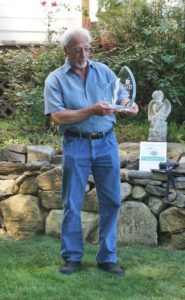 In 2013, the New Hampshire Lakes Association selected Tom Duffy, then PLIA Co-President, as its volunteer of the year, bestowing on Tom the prestigious John F. Morten Memorial Award for Exemplary Lakes Stewardship. The “Morten Award” was created in 1992 in honor of John F. Morten, in recognition of his lifelong work on behalf of New Hampshire’s lakes. John Morten is credited with having the vision and commitment to create a statewide organization to advocate on behalf of all lakes. Tom Duffy joined a long line of dedicated and effective lake stewards who have been recipients of this award and joined the company of so many other volunteers throughout New Hampshire, who together help to protect the quality of our lakes for this and future generations. Tom’s fellow volunteers on the PLIA said that his “tireless, enthusiasm, boundless energy, and consistent encouragement to promote the health of Pawtuckaway Lake sets a high standard of performance for our committed team of volunteers.”
In 2013, the New Hampshire Lakes Association selected Tom Duffy, then PLIA Co-President, as its volunteer of the year, bestowing on Tom the prestigious John F. Morten Memorial Award for Exemplary Lakes Stewardship. The “Morten Award” was created in 1992 in honor of John F. Morten, in recognition of his lifelong work on behalf of New Hampshire’s lakes. John Morten is credited with having the vision and commitment to create a statewide organization to advocate on behalf of all lakes. Tom Duffy joined a long line of dedicated and effective lake stewards who have been recipients of this award and joined the company of so many other volunteers throughout New Hampshire, who together help to protect the quality of our lakes for this and future generations. Tom’s fellow volunteers on the PLIA said that his “tireless, enthusiasm, boundless energy, and consistent encouragement to promote the health of Pawtuckaway Lake sets a high standard of performance for our committed team of volunteers.”
- In 2006, the PLIA secured a Watershed Assistance Grant from NH DES to identify and quantify specific sources of phosphorus contributing to the lake’s water quality. A thorough report and Watershed Based Plan was generated from this extensive study in 2008.
- Following a 2006 study commissioned by NHDES, a Storm Water Management Assessment was issued in 2007 with recommendations specifically for Pawtuckaway to reduce the damage caused by drainage of pollutants into the lake. The document is valuable for its descriptions of Best Practices and the creation of protective Rain Gardens.
- In 1993, the PLIA obtained a State-funded diagnostic study of the ecological health of our lake water conducted by NH DES. It also funded a program of amelioration at several off-lake sites where significant amounts of phosphorus were leaching and draining into streams that feed the lake.